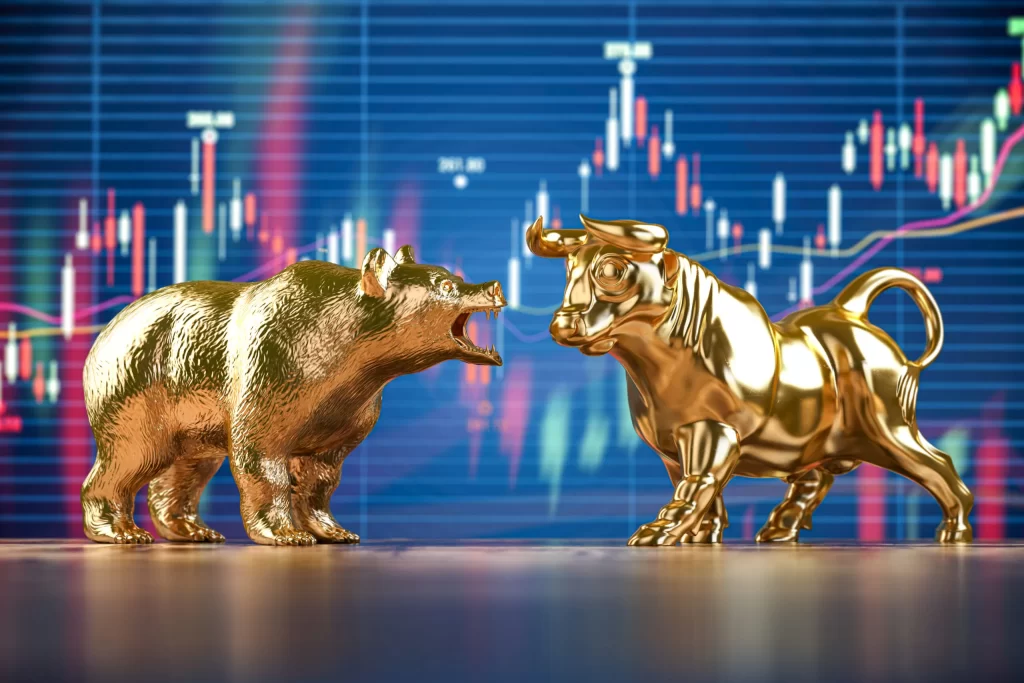Certain phrases have come to be understood as representing market attitudes and trends in the dynamic world of finance. The names “bear market” and “bull market,” which characterize the current circumstances in a particular financial market, are two examples. These phrases have their origins in conventional finance, but they have also entered the fascinating world of cryptocurrency. We’ll cover the definitions of bear and bull markets in the bitcoin business as well as their historical development in this blog article.
The causes of bull and bear markets
The names “bear market” and “bull market” have a long history that extends back to the 17th and 18th centuries and have their roots in the stock market. The phrases are thought to have originated from the divergent fighting styles of bulls and bears. In order to represent a downward market trend, bears are known to swipe their paws in that direction, whereas bulls thrust their horns upward to represent an upward market trend.
Market Bear
A prolonged period of falling prices and unfavorable market sentiment is referred to as a bear market. Investor pessimism, heightened selling pressure, and a lack of faith in the market are its defining characteristics. Asset prices often decrease during a bear market by at least 20% from previous highs. Bear markets are frequently linked to financial crises, recessions, and cyclical downturns in the economy. Investor activity tends to diminish under these circumstances because investors are more risk-averse.
Strong Market
A bull market, on the other hand, is characterized by an extended period of rising prices and a bullish market atmosphere. Investor euphoria, an uptick in purchasing, and a common conviction that the market would rise further are its distinguishing characteristics. Asset prices rise significantly during a bull market, and investor confidence is at an all-time high. Economic development, low unemployment rates, and favourable market circumstances are frequently linked to bull markets. Risk-seeking tendencies among investors often result in higher investment participation.
Markets for Cryptocurrencies: Bull and Bear
The criteria of bear and bull markets still hold true in the realm of cryptocurrencies, but there is a special twist. Due to cryptocurrencies’ extreme volatility, market trends can shift quickly, causing price moves to be exacerbated in both directions.
Bear Cryptocurrency Market
A bear market, as used in the cryptocurrency sector, is a protracted period of falling prices for several cryptocurrencies. It is characterized by a general absence of uplifting news or market catalysts, broad selling pressure, and declining trade volumes. Cryptocurrencies frequently endure significant price corrections during a bear market, sometimes even going above the 20% milestone seen in conventional markets. There are fewer new investments made as a result of investors being more cautious and a downturn in market mood.
Bullish Cryptocurrency Market
A bull market in cryptocurrencies, on the other hand, denotes an extended period of rising prices and a bullish market stance. Significant price growth, rising trading volumes, and an increase in investor zeal are its defining characteristics. Bull markets in the cryptocurrency sector frequently follow favorable legislative changes, favorable media attention, and rising blockchain use. In a bull market, the price of cryptocurrencies can rise quickly and exponentially, luring new investors hoping for bigger returns.
The cryptocurrency market has seen a number of major bull and bear movements over the past ten years, demonstrating the extraordinary volatility and speculative nature of this new asset class. Let’s examine some of the key bull and bear market trends that have affected the cryptocurrency market.
1. The 2017 Bitcoin Bull Run In the cryptocurrency market, 2017 saw one of the most notable bull markets. The biggest and most well-known cryptocurrency, Bitcoin, started on an unheard-of price rise. Bitcoin, which had a yearly average price of about $1,000, experienced an astounding surge of about 1,900% in December 2017, when it reached an all-time high of almost $20,000. Growing public interest, media attention, and an influx of new investors into the market all contributed to this bull run.
2. The 2018 Crypto Winter The cryptocurrency market endured a protracted bear market in 2018 after the amazing bull run of 2017, which is sometimes referred to as the “Crypto Winter.” Significant price decreases occurred for Bitcoin and numerous other cryptocurrencies. For instance, Bitcoin fell from its peak of around $20,000 to about $3,000 by year’s end. Regulator ambiguity, market manipulation worries, and a general lack of popular adoption were the defining characteristics of this bear market.
3. The Renewal in 2020–2021: Following the Crypto Winter, the cryptocurrency market experienced a renewal in 2020 and 2021 that was fueled by a number of causes. Global economic uncertainty and the COVID-19 pandemic both contributed to the rise in interest in cryptocurrency as a form of alternative investment. Once more taking the lead, Bitcoin went on an impressive bull run. It surpassed the previous record-high price, rising astonishingly to more than $64,000 in April 2021. This cryptocurrency bull market spread to a number of different altcoins and other cryptocurrencies, such as Ethereum.
4. The 2021 drop: The cryptocurrency market underwent a substantial drop after reaching its high in April 2021, despite the bull market of 2020–2021 that generated a great deal of excitement. An interval of consolidation and a price decline was brought on by worries about overzealous speculation, environmental effect, and regulatory activities. For instance, the price of Bitcoin dropped by around 50% from its peak, and other cryptocurrencies followed suit. This correction showed how volatile cryptocurrencies are by nature and the necessity for prudence in such markets.
Conclusion
The origins of the terms “bear market” and “bull market” in conventional finance are fascinating. However, they have successfully adapted to the distinctive features of this digital asset class and made the transfer to the cryptocurrency business. For investors and enthusiasts to make knowledgeable judgments, manage risks, and traverse the constantly-evolving cryptocurrency market, it is imperative that they understand these terminology.
There is always a chance to put money into a worthwhile cryptocurrency project, bull market or bear. Independent of the state of the market, projects with good tokenomics and a dedicated team working toward a defined plan can hold inherent value. Bear markets can present chances to invest in potential enterprises at cheaper prices, and bull markets can be exciting due to the quick price appreciation. To successfully navigate these markets, one must have a firm grasp of their dynamics, a well-informed investment plan, and a patient, long-term outlook.
The bitcoin market has already had remarkable bull runs that were followed by large corrections or bearish trends. Each of these cycles has played a crucial role in this new asset class’ maturation. The market has demonstrated amazing resilience and the possibility for future growth, not just surviving these changes but also evolving and adapting.
The experience of both bull and downturn markets serves as evidence of how volatile cryptocurrencies are. But it also teaches you how important comprehensive research, thoughtful financial choices, and risk management are. These market circumstances serve as a reminder of one of the most important investment principles: never invest more money than you can afford to lose.
In the end, the fundamental attractiveness of cryptocurrencies endures independent of market circumstances. They challenge the established financial conventions and open up a brand-new financial frontier by providing uncommon investment opportunities. The words “bear” and “bull” will continue to be significant landmarks on this journey as we further explore this fascinating area.






